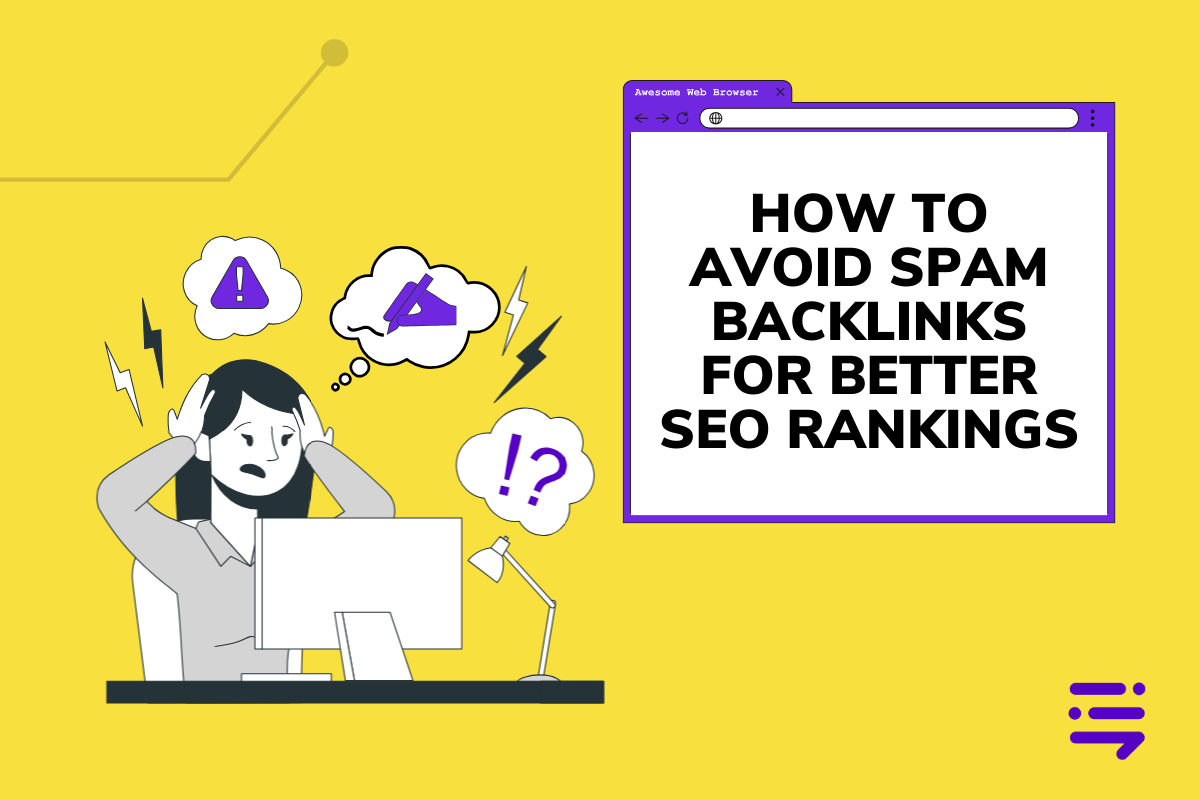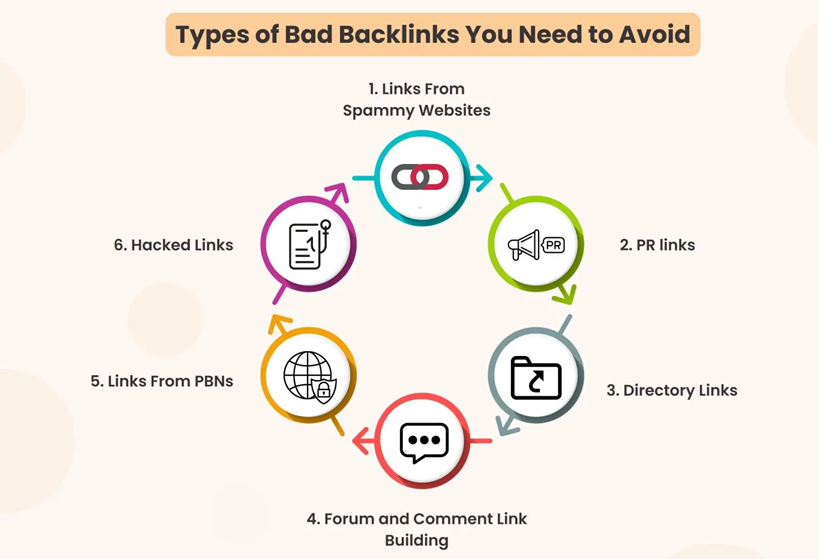Discover top guides, trends, tips and expertise from AIO Writers
How to Avoid Spam Backlinks for Better SEO Rankings
Julia McCoy
Monday, 15th Apr 2024
Have you ever wondered why, despite all your efforts, your website isn’t ranking as well as expected? The culprit might be closer than you think. Spam backlinks are like weeds in the garden of your site’s SEO; left unchecked, they can overrun the hard work you’ve put into cultivating a robust online presence.
Spam backlinks in your backlink profile could be dragging down your website’s reputation without you even realizing it. But fear not! Identifying and dealing with them isn’t as daunting as it sounds.
In this guide, you will learn what constitutes a spam backlink and how you can remove these low-quality backlinks by reaching out to website owners or using the Google Disavow tool.
Table Of Contents:
- What Are Spam Backlinks and Why Are They Bad for SEO?
- Types of Bad Backlinks to Watch Out For
- How to Identify and Remove Spam Backlinks
- Best Practices for Building High-Quality Backlinks
- FAQs – Spam Backlinks
- Conclusion
What Are Spam Backlinks and Why Are They Bad for SEO?
You’ve probably heard that backlinks are important for SEO. And you’re right, they are.
But not all backlinks are created equal. In fact, some can actually hurt your website’s search engine rankings. I’m talking about spam backlinks, also known as toxic backlinks.
Spam backlinks are links from irrelevant, spammy, or low-quality websites that are created to manipulate search engine rankings artificially. These links are often generated through automated programs, link schemes, or by leaving spammy comments on blogs and forums.
Google’s Stance on Spammy Links
Google has consistently emphasized the importance of building high-quality, natural backlinks and has warned against using spammy link-building tactics. The search engine’s algorithms are designed to identify and penalize websites that engage in link schemes or have a high number of low-quality, irrelevant backlinks.
Spam backlinks can significantly harm your website’s SEO by triggering Google’s spam detection algorithms, leading to penalties or even complete removal from search results. These low-quality links can also damage your website’s reputation and trustworthiness in the eyes of both search engines and users.
Imagine you’re a reputable business but suddenly you’re associated with a bunch of spammy websites. Not a good look, right?
Types of Bad Backlinks to Watch Out For
Now that you know what spam backlinks are and why they’re bad news, let’s dive into the different types of bad backlinks you should watch out for.
Trust me, you don’t want these links pointing to your website.
Links from Link Networks
Link networks are groups of websites created for the sole purpose of exchanging links to manipulate search engine rankings. These networks often consist of low-quality, irrelevant websites and can be detrimental to a website’s SEO if detected by search engines.
Blog Comment Spam
Blog comment spam refers to the practice of leaving irrelevant or low-quality comments on blog posts with the sole purpose of creating a backlink to a website. These comments often contain generic, spammy content and can harm a website’s reputation and search engine rankings.
You know those comments that say things like “Great post. Check out my website for amazing deals on designer handbags”? Yeah, those are blog comment spam.
Directory Links
While high-quality, relevant directory links can be beneficial, many online directories are low-quality and exist solely to sell links.
Links from these spammy directories can be considered toxic backlinks and may harm a website’s search engine rankings.
Just because a directory promises “instant SEO boost” doesn’t mean it’s legit. Stick to reputable, industry-specific directories instead.
Over-Optimized Anchor Text Links
Over-optimized anchor text links are backlinks that use the exact same keyword-rich anchor text across multiple websites. This practice can appear unnatural to search engines and may be seen as an attempt to manipulate rankings, potentially leading to penalties.
If every link pointing to your website says “best plumber in NYC,” it’s going to look suspicious. Mix up your anchor text and keep it natural, folks.

How to Identify and Remove Spam Backlinks
If you’ve ever found yourself wondering “Where the heck did all these spammy backlinks come from?” – you’re not alone. Spam backlinks are the bane of every website owner’s existence.
But fear not. I’m here to walk you through exactly how to identify and remove those pesky spam backlinks.
Collect Backlink Data
First things first – you need to know what backlinks your website actually has. This is where backlink checkers come in handy. Some of my favorites are Ahrefs, Moz’s Link Explorer, and Semrush’s Backlink Analytics.
These tools will give you a comprehensive list of all the websites linking to yours. It’s like a backlink audit on steroids.
Analyze Backlinks for Spam
Now that you’ve got your list of backlinks, it’s time to separate the wheat from the chaff. Or in this case, the quality links from the spammy ones.
Here are some red flags to watch out for:
- Links from irrelevant or low-quality websites
- Links with overly optimized anchor text (think: “buy cheap Viagra here”)
- Links from foreign language websites (unless that’s your target audience)
- Links from link directories or link farms
If a link looks shady, it probably is. Trust your gut.
Request Removal of Bad Links
Once you’ve identified the spam backlinks, it’s time to take action. The first step is to reach out to the website owner and politely ask them to remove the link.
You can usually find contact information in the website’s footer or on their “Contact Us” page. If that fails, try searching for their email address using a tool like Hunter.io.
Use Google’s Disavow Tool
If your link removal requests fall on deaf ears, don’t despair. You can still tell Google to ignore those spammy links using their Disavow Tool.
Simply create a .txt file listing all the links you want to disavow, upload it to the tool, and voila. Google will no longer take those links into account when evaluating your website.
Monitor Your Link Profile
Spam backlinks are like weeds – even if you get rid of them once, they can always come back. That’s why it’s important to regularly monitor your link profile using tools like Google Search Console.
Set up alerts so you’ll be notified any time a new backlink is detected. That way, you can nip any potential spam links in the bud before they have a chance to cause problems.
Identifying and removing bad backlinks takes a bit of elbow grease, but it’s well worth the effort. A clean, healthy link profile is crucial for SEO success.
Best Practices for Building High-Quality Backlinks
Now that we’ve covered how to get rid of the bad backlinks, let’s talk about how to get more of the good ones.
Focus on Relevance and Authority
When it comes to backlinks, quality trumps quantity every time. One link from a high-authority website in your niche is worth more than 100 links from random, low-quality sites.
So how do you determine a website’s authority? Tools like Moz’s Link Explorer and Ahrefs’ Website Authority Checker can give you a good idea.
As a general rule of thumb, aim for links from websites with a Domain Authority (DA) of 50+.

Create Valuable Content
Want to know the secret to attracting high-quality backlinks? Create content that’s so darn valuable, other websites can’t help but link to it.
We’re talking in-depth blog posts, informative infographics, and engaging videos – the kind of content that makes people go “Wow, I need to share this.”
When you create truly valuable content, the backlinks will come naturally.
Engage in Outreach and Collaboration
Sometimes, if you want something, you gotta ask for it. That’s where outreach and collaboration come in.
Reach out to other websites in your niche and propose a collaboration, like a guest post swap or a joint webinar. You scratch their back, they’ll scratch yours (with a nice, juicy backlink).
Just make sure you’re targeting websites that are actually relevant to your niche. A link from a high-authority fashion blog isn’t going to do much for your B2B software company.
Diversify Your Link Profile
When it comes to backlinks, variety is the spice of life. You don’t want all your links coming from the same source or using the same anchor text.
Mix things up by getting links from a variety of different websites and using natural, varied anchor text. This helps signal to Google that your links are organic and not the result of shady link schemes.
Building high-quality backlinks takes time and effort, but it’s one of the most important things you can do for your website’s SEO. So get out there and start earning those valuable links.
FAQs – Spam Backlinks
What is a spam backlink?
A spam backlink comes from low-quality or irrelevant sites aiming to manipulate SEO rankings.
How do I stop spam backlinks?
To block them, regularly monitor your link profile and use Google’s Disavow Tool for the shady ones.
How do I find spammy backlinks?
Leverage tools like Google Search Console or Moz to spot and analyze questionable links pointing to your site.
What are fake backlinks?
Fake backlinks are artificially created links meant to boost a website’s ranking but can seriously harm its SEO health.
Conclusion
Keeping an eye on spam backlinks is more than just housekeeping — it’s about protecting and enhancing your site’s authority and rankings.
Spam backlinks can undermine your SEO efforts and damage your site’s credibility with search engines. By regularly auditing your backlinks, disavowing harmful links, and focusing on white-hat link-building strategies, you can safeguard your website from the negative impact of spammy practices.
Remember, quality always trumps quantity when it comes to backlinks, so prioritize building relationships with trusted websites that add genuine value to your audience. By taking these steps, you’ll not only improve your search engine rankings but also create a more trustworthy and valuable online presence.

UNLOCK YOUR POTENTIAL
Long Headline that highlights Value Proposition of Lead Magnet
Grab a front row seat to our video masterclasses, interviews, case studies, tutorials, and guides.



